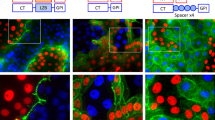Abstract
Two recent reports1,2 have suggested that the junctional membrane of the cells located at compartment boundaries in developing insect epithelia, although permeable to inorganic ions3,4, prevents the cell-to-cell transfer of the fluorescent tracer Lucifer yellow (LY). However, cells within a compartment are linked by junctions permeable to both inorganic ions and organic tracers1–5. These findings imply that junctional communication is important in tissue development and that spatial selectivity may allow developmental autonomy in nearby compartments. The observation that LY was occasionally seen to pass across the segment border of the milkweed bug Oncopeltus fasciatus1 suggested to us that the permeability of the junctions of the segment border may be locally controlled. We report here that the selectivity in the junctional channels at compartment boundaries in this insect is variable and under the control of a discrete population of border cells. The extent to which these cells reduce the rate of tracer passage across the compartment boundary relative to that within the compartment is influenced by the culture medium in which the tissue is placed.
This is a preview of subscription content, access via your institution
Access options
Subscribe to this journal
Receive 51 print issues and online access
$199.00 per year
only $3.90 per issue
Buy this article
- Purchase on Springer Link
- Instant access to full article PDF
Prices may be subject to local taxes which are calculated during checkout
Similar content being viewed by others
References
Warner, A. E. & Lawrence, P. A. Cell 28, 243–252 (1982).
Weir, M. P. & Lo, C. W. Proc. natn. Acad. Sci. U.S.A. 79, 3232–3235 (1982).
Warner, A. E. & Lawrence, P. A. Nature 245, 47–48 (1973).
Caveney, S. Devl Biol. 40, 311–322 (1974).
Caveney, S. & Podgorski, C. Tissue Cell. 7, 559–574 (1975).
Lawrence, P. A. Genet. Res. 15, 347–350 (1970).
Caveney, S. & Blennerhassett, M. G. J. Insect Physiol. 26, 13–25 (1980).
Stewart, W. W. Cell 14, 741–759 (1978).
Lawrence, P. A. J. Embryol. exp. Morph. 30, 681–699 (1973).
McLachlin, J. R., Caveney, S. & Kidder, G. M. Devl Biol. 98, 155–164 (1983).
Safranyos, R. & Caveney, S. J. Cell Biol. (submitted).
Locke, M. J. exp. Biol. 37, 398–406 (1960).
Wright, D. A. & Lawrence, P. A. Devl Biol. 85, 317–327 (1981).
Mitsuhashi, J. Jap. J. appl. Ent. Zool. 9, 107–114 (1965).
Shields, G. & Sang, J. H. J. Embryol. exp. Morph. 23, 53–69 (1970).
Author information
Authors and Affiliations
Rights and permissions
About this article
Cite this article
Blennerhassett, M., Caveney, S. Separation of developmental compartments by a cell type with reduced junctional permeability. Nature 309, 361–364 (1984). https://doi.org/10.1038/309361a0
Received:
Accepted:
Issue Date:
DOI: https://doi.org/10.1038/309361a0
This article is cited by
-
The role of gap junction membrane channels in development
Journal of Bioenergetics and Biomembranes (1996)
-
The connexin family of intercellular channel forming proteins
Kidney International (1995)
-
Communication compartments in the ectoderm of embryos of Patella vulgata
Roux's Archives of Developmental Biology (1989)
Comments
By submitting a comment you agree to abide by our Terms and Community Guidelines. If you find something abusive or that does not comply with our terms or guidelines please flag it as inappropriate.



